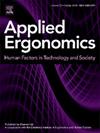Passive back support exoskeletons do not effectively reduce physical demands during simulated floor tiling
IF 3.1
2区 工程技术
Q2 ENGINEERING, INDUSTRIAL
引用次数: 0
Abstract
Back-support exoskeletons (BSEs) have the potential to reduce physical demands during many occupational tasks, but their effectiveness in flooring work remains underexplored. Eighteen participants performed simulated floor tiling work under three intervention conditions (HeroWear Apex™ = HW, Laevo Flex™ = LV, and no device = ND), across two tile sizes (small vs. large), and two task types (tiling vs. grouting). HW use increased back muscle activation by ∼13–44 % compared to ND, while LV led to minimal changes. Some participants reported concerns with both BSEs, including movement restrictions, discomfort, and skin irritation. Significant interaction effects of intervention and tile size on muscle activity and subjective outcomes suggest the importance of considering task-specificity in BSE evaluations. Overall, the BSEs examined here did not effectively reduce physical demands during simulated floor tiling. Although we assessed BSE effects on tiling, our findings could also guide future implementation of exoskeletons in other similar construction tasks.
被动的背部支持外骨骼不能有效地减少物理需求在模拟地砖
背支撑外骨骼(bse)在许多职业任务中具有降低体力需求的潜力,但其在地板工作中的有效性仍未得到充分探索。18名参与者在三种干预条件下(HeroWear Apex™= HW, Laevo Flex™= LV,无设备= ND),两种瓷砖尺寸(小与大)和两种任务类型(瓷砖与灌浆)进行模拟地板瓷砖工作。与ND相比,HW使背部肌肉激活增加了约13 - 44%,而LV导致的变化很小。一些参与者报告了对这两种疯牛病的担忧,包括行动受限、不适和皮肤刺激。干预和瓷砖大小对肌肉活动和主观结果的显著相互作用表明在疯牛病评估中考虑任务特异性的重要性。总的来说,在模拟铺地过程中,bse并没有有效地减少物理需求。虽然我们评估了疯牛病对瓷砖的影响,但我们的发现也可以指导未来在其他类似施工任务中实施外骨骼。
本文章由计算机程序翻译,如有差异,请以英文原文为准。
求助全文
约1分钟内获得全文
求助全文
来源期刊

Applied Ergonomics
工程技术-工程:工业
CiteScore
7.50
自引率
9.40%
发文量
248
审稿时长
53 days
期刊介绍:
Applied Ergonomics is aimed at ergonomists and all those interested in applying ergonomics/human factors in the design, planning and management of technical and social systems at work or leisure. Readership is truly international with subscribers in over 50 countries. Professionals for whom Applied Ergonomics is of interest include: ergonomists, designers, industrial engineers, health and safety specialists, systems engineers, design engineers, organizational psychologists, occupational health specialists and human-computer interaction specialists.
 求助内容:
求助内容: 应助结果提醒方式:
应助结果提醒方式:


